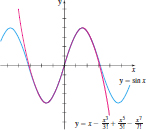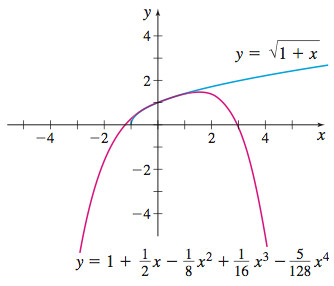8.10 Approximations Using Taylor/Maclaurin Expansions
OBJECTIVES
When you finish this section, you should be able to:
- Approximate functions and their graphs (p. 623)
- Approximate the number \(e;\) approximate logarithms (p. 625)
- Approximate definite integrals (p. 627)
1 Approximate Functions and Their Graphs
If we know the power series representation of a function or if we know the function to which a Taylor or Maclaurin series converges, we can use the first several terms of the series to approximate both the function and its graph.
624

Approximating \(y=\sin x\)
- Approximate \(y=\sin x\) by using the first four nonzero terms of its Maclaurin expansion.
- Graph \(y=\sin x\) along with the approximation found in (a).
- Use (a) to approximate \(\sin 0.1.\)
- What is the error in using this approximation?
Solution (a) The Maclaurin expansion for \(y=\sin x\) was found in Example 3 (p. 616) of Section 8.9. \[ y=\sin x=x-\dfrac{x^{3}}{3!}+\dfrac{x^{5}}{5!}-\dfrac{x^{7}}{7!}+\cdots=\sum\limits_{k\,=\,0}^{\infty }\,(-1) ^{k}\dfrac{x^{2k+1} }{(2k+1) !} \]
Using the first four nonzero terms of the Maclaurin expansion, we can approximate \(\sin x\) as \[ \begin{equation*} \sin x\approx x-\dfrac{x^{3}}{3!}+\dfrac{x^{5}}{5!}-\dfrac{x^{7}}{7!} \tag{1} \end{equation*} \]

(b) The graphs of \(y=\sin x\) and the approximation in (1) are given in Figure 29.
(c) Using (1), we get \[ \sin 0.1\approx 0.1-\dfrac{0.1^{3}}{3!}+\dfrac{0.1^{5}}{5!}-\dfrac{0.1^{7}}{7!}\approx 0.0998 \]
(d) Since the Maclaurin expansion for \(y=\sin x\) at \(x=0\) is an alternating series that satisfies the conditions of the Alternating Series Test, the error \(E\) in using the first four terms as an approximation is less than or equal to the absolute value of the \(5\)th term at \(x=0.1.\) That is, \[ E\leq \left\vert \dfrac{0.1^{9}}{9!}\right\vert = 2.\, 756\times 10^{-15} \]
NOW WORK
Problem 1.
Approximating \(y=\sqrt{1+x}\)
- Write the Maclaurin expansion for \(y=\sqrt{1+x}\) using a binomial series.
- Approximate \(\sqrt{1+x}\) using the first five terms of the Maclaurin series.
- Graph \(y=\sqrt{1+x}\) together with the first five terms of the approximation found in (b).
- Comment on the graphs in (c).
- Use the first five terms of the approximation for \(\sqrt{1+x}\) to approximate \(\sqrt{1.2}\). What is the error in using this approximation.
Solution (a) For \(-1\leq x\leq 1\), we have \begin{eqnarray}\quad \sqrt{1+x} &=&(1+x) ^{1/2}=\sum\limits_{k\,=\,0}^{\infty }{{ \dfrac{1}{2}}\choose {\vphantom{\vrule height10pt depth.2pt}k}}\,x^{k} \nonumber\\[8pt] &=& {1}+\dfrac{1}{2}{\,}x+\dfrac{\dfrac{1}{2}\left( - \dfrac{1}{2}\right) }{2!}x^{2}+\dfrac{\dfrac{1}{2}\,\left( -\dfrac{1}{2} \right) \left( -\dfrac{3}{2}\right) }{3!}\,x^{3}+\cdots +{{\dfrac{1}{2 }}\choose {\vphantom{\vrule height10pt depth.2pt}n}}x^{n}+\cdots \nonumber \end{eqnarray}
625
(b) From part (a), we have \[ \begin{equation*} \sqrt{1+x} \approx 1+\dfrac{1}{2}x-\dfrac{1}{8}x^{2}+\dfrac{1}{16}x^{3}-\dfrac{5}{128}x^{4} \tag{2} \end{equation*} \]

(c) The graphs of \(y=\sqrt{1+x}\) and the first five terms of the approximation in (2) are given in Figure 30.
(d) On the interval of convergence \([-1,1]\), the graphs are almost identical. Outside this interval, the graphs diverge.
(e) Using (2) and \(x=0.2,\) we have \[ \sqrt{1.2}\approx 1+\dfrac{1}{2}(0.2) -\dfrac{1}{8}(0.2) ^{2}+\dfrac{1}{16}(0.2) ^{3}-\dfrac{5}{128}(0.2) ^{4}=1.0954375 \]
Since the binomial series for \(y=\sqrt{1+x}\) at \(x=0.2\) is an alternating series that satisfies the conditions of the Alternating Series Test, the error \(E\) in using the first five terms of the series as an approximation of \(\sqrt{1.2}\) is less than or equal to the absolute value of the 6th term at \(x=0.2.\) That is, \[ \begin{eqnarray*} &&E\leq \left\vert \dfrac{\dfrac{1}{2}\,\left( -\dfrac{1}{2}\right) \left( -\dfrac{3}{2}\right) \left( -\dfrac{5}{2}\right) \left(- \dfrac{7}{2}\right)}{5!}\,x^{5}\right\vert \underset{\underset{\color{#0066A7}{\scriptsize\hbox{x=0.2}}}{\color{#0066A7}{\uparrow}}}{=} \dfrac{7}{256}(0.2) ^{5}= 8.\, 75\times 10^{-6}\\[-23pt] \end{eqnarray*} \]
NOW WORK
Problem 3.
2 Approximate the Number e; Approximate Logarithms
The important number \(e\), the base of the natural logarithm, is an irrational number, so its decimal expansion neither terminates nor repeats. Here, we explore one way that \(e\) can be approximated. Another important irrational number is \(\pi .\) We explore several ways to approximate \(\pi \) in Problems 18, 19, and 23.
Approximating \(e\)
Approximate \(e\) correct to within 0.000001.
Solution In Example 2 (p. 615) of Section 8.9, we showed that the Maclaurin series \(\sum\limits_{k\,=\,0}^{\infty }\dfrac{x^{k}}{k!}\) converges to \(e^{x}\) for every number \(x.\) If \(x=1,\) we have \[ e=e^{1}=1+1+\dfrac{1}{2!}+\dfrac{1}{3!}+\cdots \,+\dfrac{1}{n!}+\cdots\, =\sum\limits_{k\,=\,0}^{\infty }\dfrac{1}{k!} \]
But this series converges very slowly.
For faster convergence, we can use \(x=-1.\) Then \[ e^{-1}=1-1+\dfrac{1}{2!}-\dfrac{1}{3!}+\cdots \,+\dfrac{(-1) ^{n}}{n!}+\cdots \,=\sum\limits_{k\,=\,0}^{\infty }\dfrac{(-1) ^{k}}{k!} \]
Since this series is an alternating series that satisfies the conditions of the Alternating Series Test, we can use the error estimate for an alternating series. Since we want \(e\) correct to within 0.000001, we need the error \(E<0.000001.\) That is, we need \(\dfrac{1}{n!}<0.000001,\) or equivalently, \(n!>10^{6}\). Since \(10!= 3.6288\times 10^{6}>10^{6},\) but \(9!= 362{,}880<10^{6},\) using \(10\) terms of the Maclaurin series will approximate \(e^{-1}\) correct to within 0.000001.
626
\[ \sum\limits_{k\,=\,0}^{9}\dfrac{(-1) ^{k}}{k!}=1-1+\dfrac{1}{2}- \dfrac{1}{3!}+\dfrac{1}{4!}-\dfrac{1}{5!}+\dfrac{1}{6!}-\dfrac{1}{7!}+\dfrac{ 1}{8!}-\dfrac{1}{9!}=\dfrac{16{,}687}{45{,}360} \]
Then \[ e=\dfrac{1}{e^{-1}}= \left( \dfrac{16{,}687}{45{,}360}\right)^{-1}\approx 2.\, 718\,28 \]
correct to within 0.000001.
NOW WORK
Problem 19.
Approximate Logarithms
In Example 8 (p. 607) of Section 8.8, we integrated the geometric series \(\dfrac{1}{1-x}=\sum\limits_{k\,=\,0}^{\infty }x^{k}\), and found that \begin{equation*} \ln \frac{1}{1-x}=x+\frac{x^{2}}{2}+\frac{x^{3}}{3}+\cdots +\frac{x^{n}}{n}+\cdots \tag{3} \end{equation*} for \(-1\leq x<1.\) It might appear that this expansion can be used to compute the logarithms of numbers, but the series converges only for \(-1\leq x\,<1,\) and unless \(x\) is close to \(0,\) the series converges so slowly that too many terms would be required for practical use.
A more useful formula for computing logarithms is obtained by multiplying (3) by \((-1) \) and using the fact that \(-\ln \dfrac{1}{A}=\ln \left( \dfrac{1}{A}\right) ^{-1}=\ln A.\) Then \[ \begin{equation*} \ln (1-x) =-x-\frac{x^{2}}{2}-\frac{x^{3}}{3}-\cdots \tag{4} \end{equation*} \]
Now we replace \(x\) by \(-x.\) The result is \[ \begin{equation*} \ln (1+x) =x-\frac{x^{2}}{2}+\frac{x^{3}}{3}-\cdots \tag{5} \end{equation*} \]
Subtracting (4) from (5), we obtain \[ \begin{equation*} \ln \dfrac{1+x}{1-x}=2\! \, \left( x+\dfrac{x^{3}}{3}+\dfrac{x^{5}}{5}+\cdots \right) \tag{6} \end{equation*} \]
This series converges for \(-1<x<1.\)
If \(N\) is a positive integer, let \(x=\dfrac{1}{2N+1}.\) Then \(0<x<1,\) and \[ \dfrac{1+x}{1-x}=\dfrac{1+\dfrac{1}{2N+1}}{1-\dfrac{1}{2N+1}}=\dfrac{2N+1+1}{2N+1-1}=\dfrac{N+1}{N} \]
Substituting into (6), we obtain \[ \ln \dfrac{N+1}{N}=2 \! \,\left( x+\dfrac{x^{3}}{3}+\dfrac{x^{5}}{5}+\cdots \right) \]
Since \(x=\dfrac{1}{2N+1},\) \[ \begin{equation*} \bbox[5px, border:1px solid black, #F9F7ED]{\bbox[#FAF8ED,5pt]{\ln (N+1) =\ln N+2 \,\left[ \dfrac{1}{2N+1}+\dfrac{1}{3}\left( \dfrac{1}{2N+1}\right)^{3}+\dfrac{1}{5}\left( \dfrac{1}{2N+1}\right)^{5}+\cdots \right] }} \tag{7} \end{equation*} \]
This series converges for all positive integers \(N.\)
627
Approximating a Logarithm
- Approximate \(\ln 2\) using the first three terms of (7).
- Approximate \(\ln 3\) using the first three terms of (7).
Solution (a) In (7), we let \(N=1\) and use the first three terms of the series; then \[ \ln 2\approx 2 \, \left[ \frac{1}{3}+\frac{1}{3}\left( \frac{1}{3}\right) ^{3}+\frac{1}{5}\left( \frac{1}{3}\right) ^{5} \right] \approx 0.693004 \]
(The first three terms of this series approximates \(\ln 2\) correct to within 0.001.)
(b) To find \(\ln 3\), let \(N=2\) and use \(\ln 2=0.693004\) in (7). \begin{eqnarray*} \ln 3 & \approx & \ln 2+2 \,\left[ \dfrac{1}{5}+\dfrac{1}{3}\left( \dfrac{1}{5} \right) ^{3}+\dfrac{1}{5}\left( \dfrac{1}{5}\right) ^{5}\right] \\ & \approx & 0.693004+2\left[ \dfrac{1}{5}+\dfrac{1}{3}\left( \dfrac{1}{5}\right) ^{3}+ \dfrac{1}{5}\left( \dfrac{1}{5}\right) ^{5}\right] \approx 1.098465 \end{eqnarray*}
Continuing in this way, a table of natural logarithms can be formed.
NOW WORK
Problem 15.
3 Approximate Definite Integrals
We have already discussed the approximation of definite integrals using Riemann sums, the trapezoidal rule, and Simpson’s rule. Taylor/Maclaurin series can also be used to approximate definite integrals.
Using a Maclaurin Expansion to Approximate an Integral
Use a Maclaurin expansion to approximate \(\int_{0}^{1/2}e^{-x^{2}}dx\) correct to within 0.001.
Solution Replace \(x\) by \(-x^{2}\) in the Maclaurin expansion for \(e^{x}\) to obtain the Maclaurin expansion for \(e^{-x^{2}}\). \[ \begin{eqnarray*} e^{x} &=& 1+x+\dfrac{x^{2}}{2!}+\dfrac{x^{3}}{3!}+\,...\, \\[7pt] e^{-x^{2}} &=& 1-x^{2}+\frac{x^{4}}{2!}-\frac{x^{6}}{3!}+\frac{x^{8}}{4!}-\cdots \end{eqnarray*} \]
Now use the integration property of power series. \[ \begin{eqnarray*} \int_{0}^{1/2}e^{-x^{2}}dx &=& \int_{0}^{1/2}\left( 1-x^{2}+\frac{x^{4}}{2!}-\frac{x^{6}}{3!}+\cdots \right)\,dx \\[9pt] &=& \left[ x-\frac{x^{3}}{3}+\frac{x^{5}}{2!5}-\frac{x^{7}}{3!7}+\cdots \right] _{0}^{1/2} \\[9pt] &=& \frac{1}{2}-\frac{1}{3(2)^{3}}+\frac{1}{2!5(2)^{5}}-\frac{1}{3!7(2)^{7}}+\cdots \\[9pt] &\approx & 0.5-0.041666+0.003125-0.000186+\cdots \end{eqnarray*} \]
Since this series satisfies the two conditions of the Alternating Series Test, the error due to using the first three terms as an approximation is less than the 4th term,
628
\(\dfrac{1}{3!7(2)^{7}}= 1.\, 860119048\times 10^{-4}. \) So, \[ \int_{0}^{1/2}e^{-x^{2}}dx\approx \frac{1}{2}-\frac{1}{3(2)^{3}}+\frac{1}{2!5(2)^{5}}\approx 0.461458 \]
correct to within \(0.001\).
NOW WORK
Problem 9.
Notice that only three terms were needed to obtain the desired accuracy. To obtain this same accuracy using Simpson’s rule or the trapezoidal rule would have required a very fine partition of \(\left[ 0,\,\dfrac{1}{2}\right] \). In practice, efficiency of technique is an important consideration for solving numerical problems.